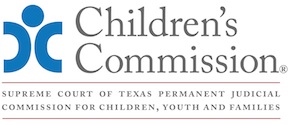D. Judicial Review
The judiciary is charged with oversight of the safety, permanency, and well-being of the children in their courts. Tex. Fam. Code § 266.007 requires that the judge overseeing the case review a summary of the medical care being provided to the child at each hearing held pursuant to Tex. Fam. Code Chapter 263, specifically the Permanency Hearings Before and After Final Order.
1. Court Shall Review Medical Summary
Tex. Fam. Code Chapter 266 requires the summary of medical care to include:
• The nature of any emergency medical care provided to the child and the circumstances necessitating emergency medical care, including any injury or acute illness suffered by the child;
• All medical and mental health treatment that the child is receiving and the child's progress with the treatments;
• Any medication prescribed for the child and the condition, diagnosis, and symptoms for which the medication was prescribed and the child's progress with the medication;
• The degree to which the child or foster care provider has complied or failed to comply with any plan of medical treatment for the child;
• Any adverse reaction to or side effects of any medical treatment provided to the child;
• Any specific medical condition of the child that has been diagnosed or for which tests are being conducted to make a diagnosis; and
• Any activity that the child should avoid or should engage in that might affect the effectiveness of the treatment, including physical activities, other medications, and diet. Tex. Fam. Code § 266.007.
Additional information may be required to effectively oversee that informed consent has been given. Tex. Fam. Code Chapter 266 requires that judges review the medical care at each hearing conducted under Tex. Fam. Code Chapter 263.
The court must determine whether the child has been provided the opportunity, in a developmentally appropriate manner, to express opinion about medical care. Tex. Fam. Code § 263.306(a-1)(5)(D). For a child receiving psychotropic medication, the court must determine whether the child has:
• Been provided appropriate psychosocial therapies, behavior strategies, and non-pharmacological interventions; and
• Seen their prescribing physician at least every 90 days for review. Tex. Fam. Code § 263.306(a-1)(5)(F).
2. Youth in Foster Care Must Be Heard at Each Hearing Held Under Tex. Fam. Code Chapter 263
The Family Code provides that sixteen and seventeen-year-olds can serve as their own medical consenter with a judicial determination that the youth is capable of the role. Tex. Fam. Code § 266.010. If the youth is not the medical consenter, Tex. Fam. Code § 266.007(c) requires that the youth be provided the opportunity to express to the court their views on the medical care being provided. Further, Tex. Fam. Code § 263.302 requires that the youth attend Permanency Hearings Before and After Final Order.
Special Issue: Although it may be difficult to routinely include youth in their hearings, supporting youth attendance and participation in hearings is very important. This is especially impactful for older youth, as they are more likely than younger youth to be prescribed psychotropic medications.
The regular use of videoconferencing has now made it easier for youth to attend hearings and judges should consider the mental health benefits of doing so for a youth when given the opportunity for youth to advocate for themselves. For more ideas on involving youth in the court process, see the Child and Youth Voice chapter of this Bench Book.
3. Judicial Psychotropic Medication Information Line
Judges can contact the Judicial Medication Information Email Box which allows judges to submit a request for general medication information to SH_JudicialMailbox@superiorhealthplan.com. Judges should expect a response to general questions within 5 business days. Additionally, Superior HealthPlan now has a Manager of Service Coordination dedicated to their judicial program. Veronica Perkins can be reached at Veronica.A.Perkins@superiorhealthplan.com or by cell at 210-262-2769.
Emails are reviewed by a STAR Health Behavioral Health Service Coordinator, who has support from the STAR Health Behavioral Health Team, including a Medical Director (child psychiatrist), a Clinical Pharmacist, and Clinical Managers. (An example of an appropriate type of question for the email box is: “What are the side effects of a medication or combination of medications on a 12-year-old girl who weighs 100 pounds?”)
The STAR Health MCO also maintains a 24/7 Behavioral Health hotline with access to behavioral health professionals when urgent needs arise. The hotline can be reached at 1-866-912-6283. For more details on this program, see Health Care for Texas Children in Foster Care: STAR Health chapter of this Bench Book.
4. Some Courts Use Standardized Court Report
A standardized court report may help provide a summary of medical information that directly follows Tex. Fam. Code § 266.007. A standardized report may include the child's age and weight as well as information about medication and dosage, condition and diagnosis, symptom(s) being treated, last medication review, and the prescribing physician.
5. Some Courts Use Specific Forms and Practices
Some Texas child welfare judges have adopted a practice of ordering that in non-urgent situations, medical consenters must appear in court before giving consent to medication treatments that fall outside the Parameters. Also, to augment the information-sharing process, some judges ask the medical consenters to complete a checklist of questions before appearing in court to ensure that the consenter considered the many steps to informed consent (as defined by the Parameters).
